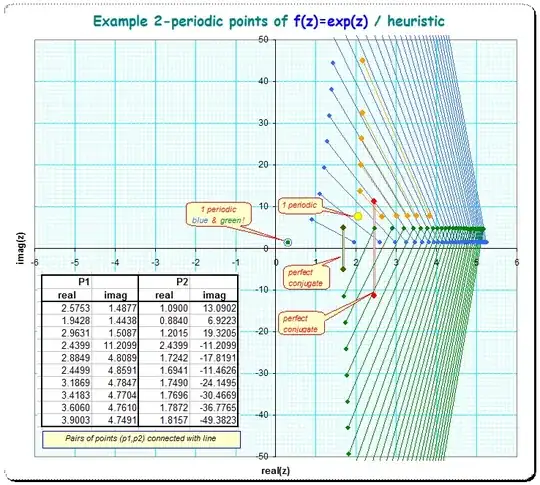Questions
$$ S(n,x) = x+e^x + e^{e^x} + e^{e^{e^x}} + \dots \text{$n$ times}$$
Also obeys (see background for argument):
$$ \frac{1}{2 \pi i} \oint e^{S(k,x)} \frac{\partial \ln(\frac{\int_0^\infty e^{-t} t^k dt }{ \int_0^\infty e^{-t} t^{(k-n)} dt})}{\partial k} dk = \frac{\partial S(n,x)}{\partial x}$$
Can this be used in the Borel summation sense for divergent series? If so, when can it be used for analytical continuity (convergence issues)? Is it useful(intuitively I feel it should be more powerful than Borel summation)? In the following heuristic sense:
$$ \kappa = \sum_{n=1}^\infty a_n = \sum_n a_n \frac{\frac{\partial S(n,x)}{\partial x}}{1 + e^x + e^x e^{e^x} + e^x e^{e^x} e^{e^{e^x}} + \dots \text{$n$ times} } $$
Using the L.H.S of the first equation:
$$ \kappa = \frac{1}{2 \pi i} \sum_n a_n \frac{\oint e^{S(k,x)} \frac{\partial \ln(\frac{\int_0^\infty e^{-t} t^k dt }{ \int_0^\infty e^{-t} t^{(k-n)} dt})}{\partial k} dk }{1 + e^x + e^x e^{e^x} + e^x e^{e^x} e^{e^{e^x}} + \dots \text{$n$ times} } $$
Swapping order of summation and contour integral:
$$ \kappa =^! \frac{1}{2 \pi i} \oint e^{S(k,x)} \sum_n \frac{ a_n \frac{\partial \ln(\frac{\int_0^\infty e^{-t} t^k dt }{ \int_0^\infty e^{-t} t^{(k-n)} dt})}{\partial k} }{1 + e^x + e^x e^{e^x} + e^x e^{e^x} e^{e^{e^x}} + \dots \text{$n$ times} }dk $$
How can I make this rigorous?
Background
I've been recently studying the following series:
$$ S(n,x) = x+e^x + e^{e^x} + e^{e^{e^x}} + \dots \text{$n$ times}$$
Where the $n$'th term is raising the $x$ exponentially $n$ number of times.
$$ b_n(x) = \underbrace{e^{e^{e^{\dots}x}}}_{\text{$n$ times exponentially raised}} $$
$n$ number of times.
Hence, we notice:
$$ e^{S(r,x)} = \frac{\partial b_{r+1}(x)}{\partial x}$$
Summing both sides and defining $S(0,x) \equiv 0$:
$$ \sum_{r=0}^n e^{S(r,x)} = \sum_{r=1}^{n+1} \frac{\partial b_{r}(x)}{\partial x} $$
Hence, we get:
$$ \sum_{r=0}^n e^{S(r,x)} = \frac{\partial S(n+1,x)}{\partial x}$$
Rewriting the R.H.S using complex analysis as a contour integral over the whole complex plane:
$$\frac{1}{2 \pi i} \oint \sum_{r=0}^n \frac{e^{S(k,x)}}{k-r}dk = \frac{\partial S(n+1,x)}{\partial x}$$
Taking $e^{S(k,x)}$ common:
$$ \frac{1}{2 \pi i} \oint e^{S(k,x)} \sum_{r=0}^n \frac{1}{k-r}dk = \frac{\partial S(n+1,x)}{\partial x}$$
Further using $d \ln x = dx/x$
$$ \frac{1}{2 \pi i} \oint e^{S(k,x)} \sum_{r=0}^n d \ln({k-r}) = \frac{\partial S(n+1,x)}{\partial x}$$
Rewriting as factorial:
$$ \frac{1}{2 \pi i} \oint e^{S(k,x)} \frac{\partial \ln(\frac{(k)!}{(k-n-1)!})}{\partial k} dk = \frac{\partial S(n+1,x)}{\partial x}$$
Analytically continuing $k!$ using the gamma function:
$$ \frac{1}{2 \pi i} \oint e^{S(k,x)} \frac{\partial \ln(\frac{\int_0^\infty e^{-t} t^k dt }{ \int_0^\infty e^{-t} t^{(k-n-1)} dt})}{\partial k} dk = \frac{\partial S(n+1,x)}{\partial x}$$
